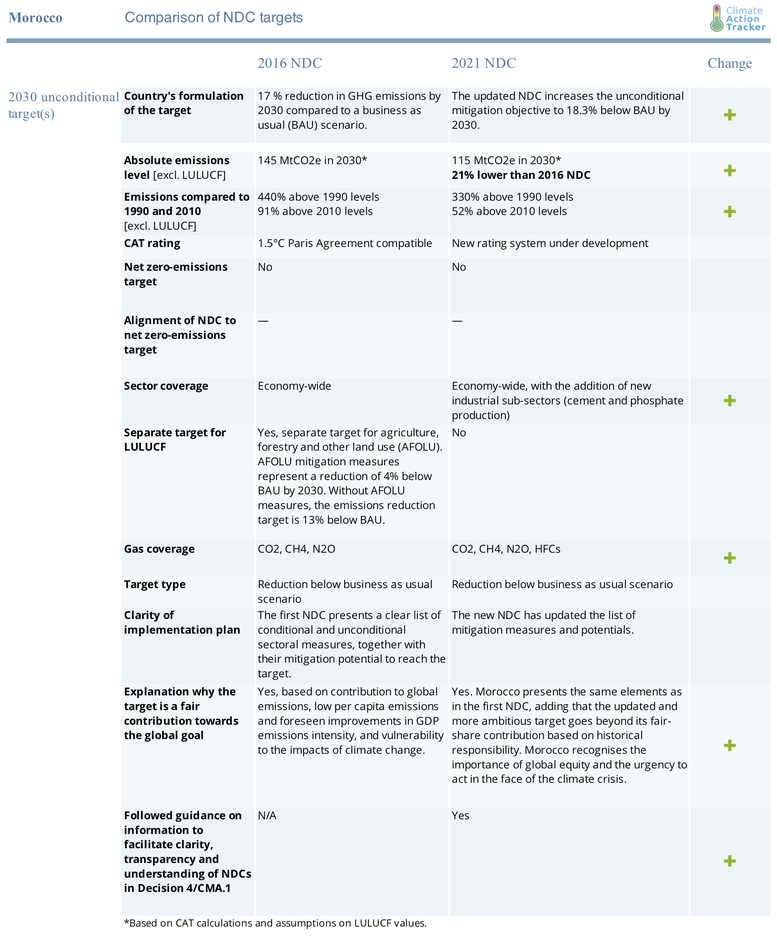Summary
Morocco leads the way with a new, more ambitious NDC
Morocco’s updated NDC, submitted on 22 June 2021, strengthens its 2030 target, improving it in two ways. First, both the unconditional and conditional 2030 emissions reduction targets have been revised to be more ambitious—from 17% to 18.3% below the business as usual (BAU) scenario for the unconditional target and from 42% to 45.5% for the conditional one. Morocco has also revised downwards the BAU scenario, to which the reduction targets are applied. For the unconditional target, this leads to 21% lower emissions (excl. LULUCF) in 2030 compared to the first NDC submission, and 29% for the conditional target.
CAT analysis of the unconditional target

With its new NDC, Morocco shows commitment to the principles of the Paris Agreement by strengthening its pledge. Despite being a developing country with low per capita emissions, Morocco is taking responsibility in the face of a global climate crisis.
The new target proposes an emissions reduction of 18.3% below BAU by 2030, up from a 17% reduction in the previous NDC. Thanks to an updated BAU scenario, the new target translates to an absolute emissions level that is 21% lower than that of the previous target—from 145 MtCO2e in the 2016 submission to 115 MtCO2e in the latest one (excluding LULUCF).
Morocco has put forward a detailed list of measures it will deploy to reach this new NDC target, separated into conditional and unconditional measures, with many of them already under implementation. It also mentions national strategies and plans, such as the national energy strategy, which aims to reduce energy consumption by 20% compared to a BAU scenario in 2030 and to reach a share of 52% of renewable energy in installed electric capacity by 2030.
However, there are measures that could jeopardise long-term decarbonisation and lead to either a lock-in of emissions or stranded assets, with the new NDC including plans to build additional natural gas infrastructure. The Moroccan electricity mix also continues to rely heavily on coal, which supplied over two-thirds of electricity demand in 2019. By 2040, coal-based electricity needs to be phased out globally, and much earlier for many regions. For the Middle East and Africa region, coal-based electricity would need to be reduced by 80% in 2030 (compared to 2010) and phased out by 2034.
The new NDC also comes with some additional improvements. Whereas the previous NDC already covered all sectors, the latest NDC has incorporated additional sub-sectors under industry—cement and phosphate production. The NDC pledge now adds hydrofluorocarbons in addition to the gases it previously included (carbon dioxide, methane, and nitrous oxide).
Some elements are still missing, or could be improved. Morocco still has a reduction target below a BAU scenario. Having a target expressed as an absolute emissions level or a reduction below a fixed base year would make the target more transparent. Morocco has also not yet put forward a net zero emissions target. Having a long-term, Paris Agreement compatible objective is important to ensure the short and medium-term are aligned with the long-term objective.

CAT analysis of the conditional target
The conditional target is strengthened from 42% to 45.5% below BAU by 2030 (both including LULUCF), and is conditional on international support, including financial. Morocco estimates the costs related to the conditional target to be USD 24 billion. This new conditional target, combined with the lower BAU scenario in the new NDC, leads to absolute emissions decreasing by 29% compared to the 2016 pledge—from 107 MtCO2e to 75 MtCO2e (excluding LULUCF).

Assumptions
LULUCF
Morocco’s NDC targets apply to all sectors. In the CAT, we exclude LULUCF from the NDC target calculations. As Morocco’s new pledge only provides economy-wide BAU values, we have taken BAU LULUCF values for 2030 from the Third National Communication submitted to the UNFCCC in 2016, and deducted these from the economy-wide 2030 BAU scenario presented in the NDC. We have also excluded LULUCF-related mitigation measures from the long list of mitigation measures used to determine the mitigation target.
Global Warming Potentials
Morocco previously used Global Warming Potential (GWP) values from the IPCC Second Assessment Report (SAR). In the new NDC, GWP are communicated using the Fourth Assessment Report (AR4) values. The CAT reports all results using AR4 GWP.
Links
Stay informed
Subscribe to our newsletter